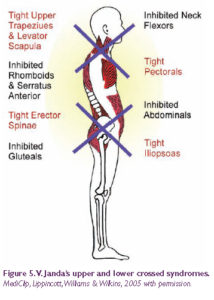Reasons You Have Neck Pain And How to Get Better
Why does Neck Pain Happen?
“I must have slept wrong!” is a statement that I often hear from patients who are experiencing acute neck pain. It’s human nature to look for the simplest reason for our problems. We also tend to stop looking when we’ve found one probable cause, even if other causes exist. These biases push us to focus mainly on short term factors that are simpler to understand. Multiple causative factors add together to cause our problems. Considering the facts, sleeping wrong is only one of many causes of neck pain. Most neck pain, like most musculoskeletal pain, is caused by poor daily postural habits gradually leading to more chronic postural distortion and limited mobility.
Let’s consider what happens when you use a smartphone or computer. Your head is shifted forward and you look down. The average human head weighs 9-12 pounds, and that’s how much a bowling ball weighs! For every inch that your head shifts forward away from your center of gravity, the weight of your head functionally doubles according to the laws of physics. This dramatically increases your risk of neck pain because of the increased strain on muscles and joints over time.
What can you do to prevent this and to rehabilitate your neck? It’s easy to get started, but expect that it will be difficult to maintain daily motivation to get better. Once you decide to make a change, simply practice shifting your gaze downwards so you’re using your eyes’ movement range instead of your neck’s range.
How to Fight Neck Pain by Using Your Eyes.
Owls are known for their uncanny ability to twist their necks so far around that they are nearly facing forwards again; they can move through about 270 degrees of rotation, whereas we can move through about 70 degrees. The reason they need this amazing range is because they have fixed eyes; they cannot move their eyes independently from their heads! We can, so we should use our eye muscles to look as far down as we can comfortably.
Also, your eye muscles’ endurance is much greater than your neck muscles’ endurance. An optometrist once told me, “The muscles of the human eye are 50 times stronger than they need to be to move the eye.” Compared to our neck muscles, their strength to mass ratio is much higher. Because of this, we should use our eyes’ movement more than our neck’s movement, especially when you must hold your neck still for awhile or when frequent repetitive movement is necessary.
The Reason Your Pillow Position Matters.
However, sleeping position is important in the practice of avoiding neck pain. The key is to keep your neck in a neutral position so that all of your muscles are as relaxed as possible. Sleeping on your back is best because it’s easier to keep your neck centered. Another advantage of the supine sleeping position is the opportunity it provides you to support the curve of your neck by placing a pillow underneath it. You can do this by bunching up the pillow so that you can feel it gently pressing up into your neck. Alternatively, you can get a pillow with a curved shape to maintain your cervical curve, similar to the lumbar support cushions seen in chairs.
 When you are sleeping on your side, the height of your pillow is the most important thing. If your pillow is too thick, your head will be tilted toward the ceiling, pulling your muscles and joints away from their most relaxed position in the center. If the pillow is too thin, your head will be tilted toward the floor with similar risks. Please remember that you want your neck to be as centered as possible. Making these changes to your daily and nightly habits may help you to avoid neck pain. Perfect practice makes perfect, so please start today! Even a few minutes of practice every day can make a very positive impact on your neck posture and your overall health.
When you are sleeping on your side, the height of your pillow is the most important thing. If your pillow is too thick, your head will be tilted toward the ceiling, pulling your muscles and joints away from their most relaxed position in the center. If the pillow is too thin, your head will be tilted toward the floor with similar risks. Please remember that you want your neck to be as centered as possible. Making these changes to your daily and nightly habits may help you to avoid neck pain. Perfect practice makes perfect, so please start today! Even a few minutes of practice every day can make a very positive impact on your neck posture and your overall health.


